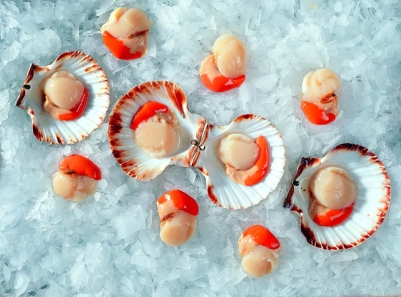Scallops
|
The attractive fan-shaped shells contain translucent off-white meat wrapped with a bright orange roe or coral, which has a different taste and texture. The membrane, grey-brown frill and black thread of intestine are all discarded - these are inedible. King Scallops have approximately 15cm wide shells (one rounded, one flat) and you get 18 to 35 pieces of meat per kg. Queen Scallops have approximately 7cm wide shells (both rounded), and you get 40 to 120 pieces of meat per kg. They can be sold either in the shell or as shelled meat – with or without the roe. The easiest way of catching Scallops is through dredging, but we also have a market for premium quality diver-caught Scallops. A superb starter with or without shells, Scallop meat has a sweet, delicate flavour, and requires very little cooking – the simpler the better. Best either steamed, pan- fried or grilled.
Buyer's Top Tips 1) Know the method of production Scallops can be harvested from wild or cultivated stocks. They can be cultivated in suspended culture or on the seabed. You should know the method of production, since scallops grown in different environments have different characteristics in terms of meat content, shelf life and biofouling (barnacles, algae etc.) on the shells. These can all affect marketability. 2) Know your species, source of supply and stock status Scallop species differ in taste and appearance. Traceability systems can help to assure the origin of product. To understand fully the sustainability issues concerned with your supply you need to know the stock from which it has-been caught. The table on pages 3 and 4 of the responsible sourcing guide gives a list of species, fisheries and current stock status. 3) Ask about the method of capture Buying policies should bear in mind the environmental effects of the method of capture; there is a gradient of increasing environmental effects from diving, through trawling to dredging. These environmental effects can be mitigated by suitable managementpractices. 4) Be aware of biotoxins Scallops can accumulate naturally occurring marine biotoxins which can, in exceptional circumstances, render scallops unfit for human consumption. In Europe suppliers have to demonstrate compliance with an end product standard and its traceability source. 5) Use the Seafish Responsible Sourcing Service Seafish have developed a tool to assist in the responsible sourcing of seafood. This RASS tool is available on the Seafish website.
|
|||||


